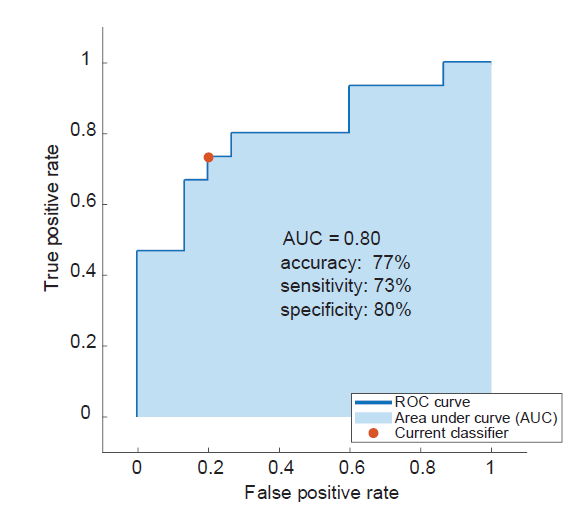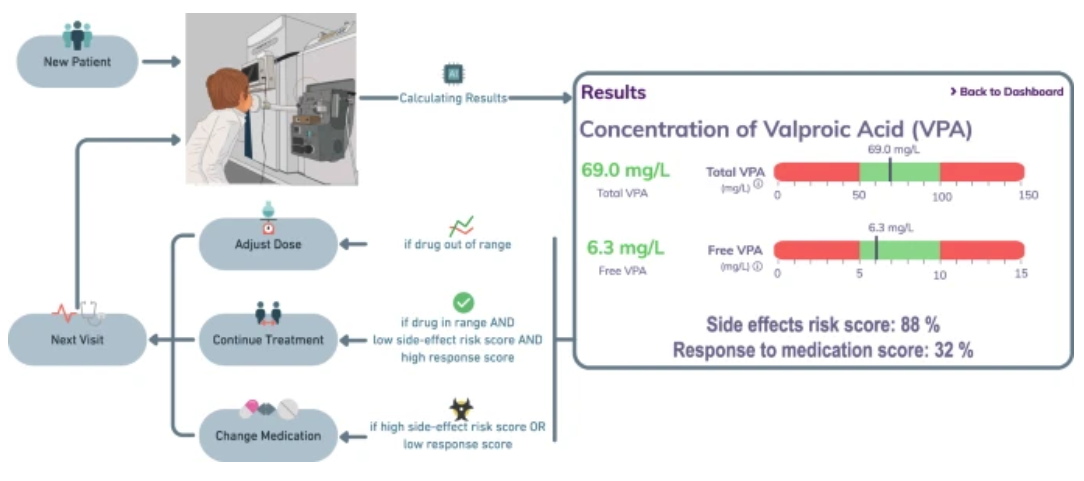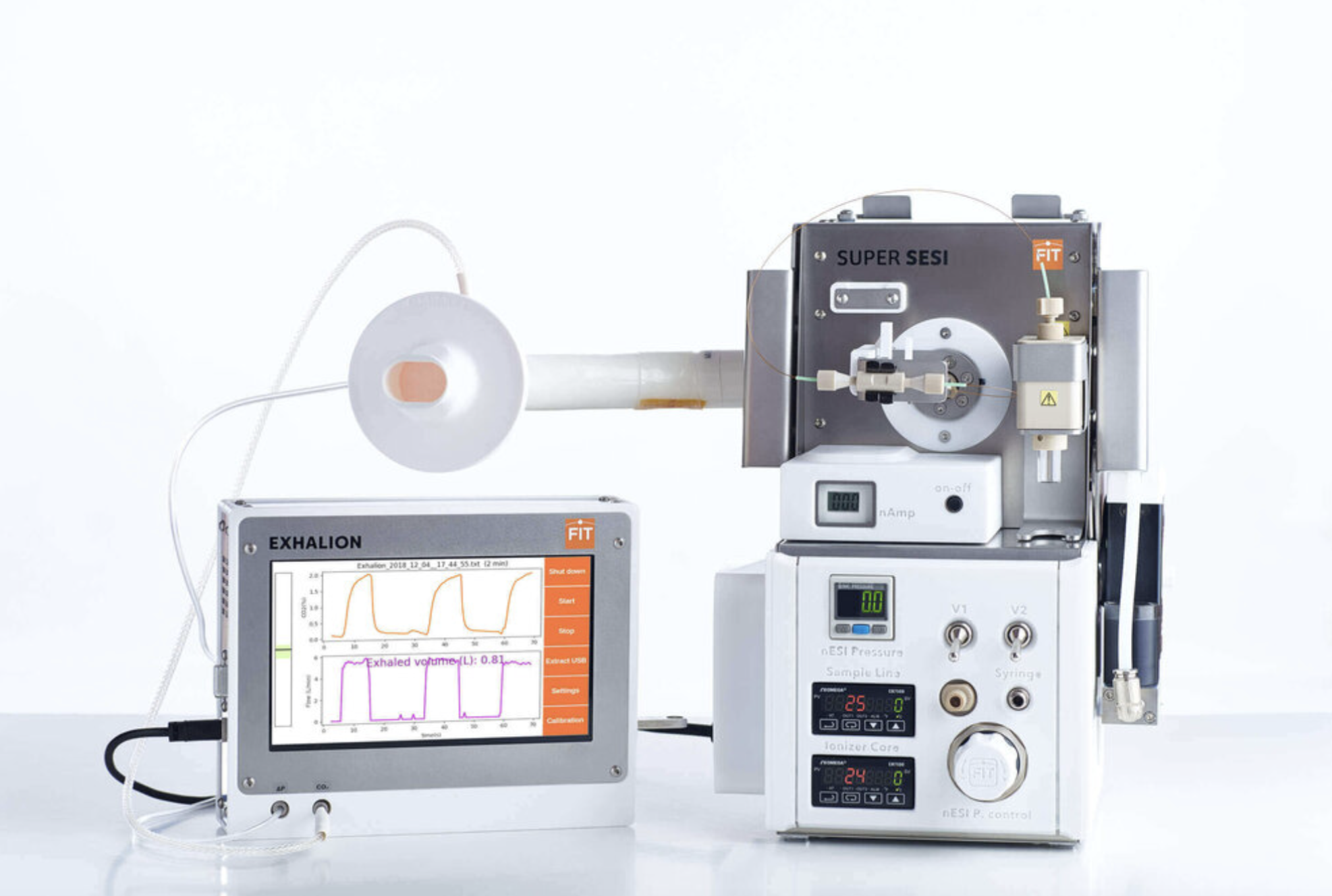Rapid detection of Staphylococcus aureus and Streptococcus pneumoniae by real-time analysis of volatile metabolites
A. Gómez-Mejia, K. Arnold, J. Bär, K. Dev Singh, T. C. Scheier, S. D. Brugger, A. S. Zinkernagel, P. Sinues
Early detection of pathogenic bacteria is needed for rapid diagnostics allowing adequate and timely treatment of infections.
Validating Discriminative Signatures for Obstructive Sleep Apnea in Exhaled Breath
B. Streckenbach, M. Osswald, S. Malesevic, R. Zenobi, and M. Kohler
Chemical analysis of exhaled breath have suggested the existence of an OSA-specific metabolic signature. Here, we validated this diagnostic approach and the proposed marker compounds, as well as their potential to reliably diagnose OSA.
Breath response following a nutritional challenge monitored by secondary electrospray ionization high-resolution mass spectrometry
C. Wüthrich, M.de Figueiredo, K. J. Burton-Pimentel, G. Vergères, F. Wahl, R. Zenobi and S. Giannoukos
For the first time, this study demonstrates the application of SESI-HRMS in the field of nutritional science using a standardized nutritional intervention, consisting of a high-energy shake. Tentative compounds include fatty acids, amino acids, and amino acid derivatives, some of them likely derived from nutrients by the gut microbiome, as well as organic acids from the Krebs cycle. Time-series clustering showed an overlap of observed kinetic trends with those reported previously in blood plasma.
In vivo detection of metabolic 2H-incorporation upon ingestion of 2H2O
Kim Arnold, Xing Chen, Hui Zhang, Kapil Dev Singh, Zhihong Yin, Yao Yao, Tiangang Luan, Pablo Sinues, and Xue Li
Secondary electrospray ionization-high resolution mass spectrometry allows monitoring in vivo 2H-incorporation of metabolites in a non-invasive and real-time setup and opens new opportunities to use 2H tracing to extend current metabolic studies, especially those with a focus on anaerobic glycolysis, lysine methylation and gut microbiome via monitoring of short-chain fatty acids.
Asthma in One Breath - Metabolic Signatures for Allergic Asthma in Children by Online Breath Analysis: An Observational Study
R. Weber, B. Streckenbach, L. Welti, D. Inci, M. Kohler, N. Perkins, R. Zenobi, S. Micic⋆, A. Moeller
Breath analysis was performed via a SESI source linked to a high-resolution mass spectrometer. 48 allergic asthmatics and 56 healthy controls were included in the study. We found several pathways that are well-represented by the significant metabolites, for example lysine degradation elevated in the asthmatic group and two arginine pathways in the healthy group. For the first time, a large number of breath-derived volatile organic compounds (VOCs) that discriminate children with allergic asthma from healthy controls were identified. Many are linked to well-described metabolic pathways and chemical families involved in pathophysiological processes of asthma. Furthermore, a subset of these VOCs showed high potential for clinical diagnostic applications.
Personalised therapeutic management of epileptic patients guided by pathway-driven breath metabolomics
Kapil Dev Singh, Martin Osswald, Victoria C. Ziesenitz, Mo Awchi, Jakob Usemann, Lukas L. Imbach, Malcolm Kohler, Diego García-Gómez, Johannes van den Anker, Urs Frey, Alexandre N. Datta & Pablo Sinues
Therapeutic management of epilepsy remains a challenge, since optimal systemic antiseizure medication (ASM) concentrations do not always correlate with improved clinical outcome and minimal side effects. We tested the feasibility of noninvasive real-time breath metabolomics as an extension of traditional therapeutic drug monitoring for patient stratification by simultaneously monitoring drug-related and drug-modulated metabolites.
Real-time (on-line) chemical characterisation of thermal aerosols by super secondary electrospray ionization coupled with high-resolution mass spectrometry (Super SESI-HRMS)
T. Živković Semren, S. Majeed, M. Fatarova, C. Laszlo, C. Pak, S. Steiner, A. Kuczaj, A. Mazurov, M. Peitsch, N. Ivanov, J. Hoeng, and P. A. Guy
We used a programmable dual syringe pump (PDSP) connected to a super secondary electrospray ionisation (SESI) system interfaced with a Q Exactive HF mass spectrometer (MS) to detect the main constituents of thermally generated aerosols in real time. The benefits of Super SESI–HRMS for detecting drug aerosolisation from variably prepared in-house formulations with anatabine, azithromycin, chloroquine, favipiravir, and hydroxychloroquine were evaluated.
In vivo monitoring of volatile metabolic trajectories enables rapid diagnosis of influenza A infection
Zhihong Yin, Wenbo Huang, Kapil Dev Singh, Zhaoming Chen, Xing Chen, Zhen Zhou, Zifeng Yang, Pablo Sinues and Xue Li
We report that influenza A virus infection induces changes in odor traits that could be captured by real-time high-resolution mass spectrometry in a living mouse model. The most striking changes in the volatile metabolites may be associated mostly to glyoxylate/dicarboxylate metabolism.
Validation of breath biomarkers for obstructive sleep apnea
Nora Nowak, Anna Engler, Sira Thiel, Anna S. Stöberl, Pablo Sinues, Renato Zenobi, Malcolm Kohler
Here, we could confirm significant differences between metabolic patterns in exhaled breath from OSA patients compared to control subjects without OSA as well as the association of breath biomarker levels with disease severity. Our prediction of the diagnosis for the patients from this completely independent validation study using a classification model trained on the data from the previous study resulted in an area under the receiver operating characteristic curve of 0.66, which is comparable to questionnaire-based OSA screenings.
Volatile organic compound breath signatures of children with cystic fibrosis by real-time SESI-HRMS
Ronja Weber, Naemi Haas, Astghik Baghdasaryan, Tobias Bruderer, Demet Inci, Srdjan Micic, Nathan Perkins, Renate Spinas, Renato Zenobi, Alexander Moeller
Early pulmonary infection and inflammation result in irreversible lung damage and are major contributors to cystic fibrosis (CF)-related morbidity. An easy to apply and noninvasive assessment for the timely detection of disease-associated complications would be of high value. We aimed to detect volatile organic compound (VOC) breath signatures of children with CF by real-time secondary electrospray ionisation high-resolution mass spectrometry (SESI-HRMS).
A total of 101 children, aged 4–18 years (CF=52; healthy controls=49) and comparable for sex, body mass index and lung function were included in this prospective cross-sectional study. Exhaled air was analysed by a SESI-source linked to a high-resolution time-of-flight mass spectrometer. Mass spectra ranging from m/z 50 to 500 were recorded.
Out of 3468 m/z features, 171 were significantly different in children with CF (false discovery rate adjusted p-value of 0.05). The predictive ability (CF versus healthy) was assessed by using a support-vector machine classifier and showed an average accuracy (repeated cross-validation) of 72.1% (sensitivity of 77.2% and specificity of 67.7%).
This is the first study to assess entire breath profiles of children with SESI-HRMS and to extract sets of VOCs that are associated with CF. We have detected a large set of exhaled molecules that are potentially related to CF, indicating that the molecular breath of children with CF is diverse and informative.
Identification of disease-specific molecular breath profiles in patients with allergic asthma
Ronja Weber, Srdjan Micic, Bettina Streckenbach, Lara Welti, Tobias Bruderer, Nathan Perkins, Demet Inci, Jakob Usemann, Alexander Möller
The diagnosis of asthma in children is still a clinical challenge. Breath-analysis has the potential to overcome this challenge. Our goal is to show that secondary electrospray ionization high-resolution mass-spectrometry (SESI-HRMS) can be used to detect asthma-specific metabolites in exhaled breath.
We are conducting an exploratory observational study comparing the molecular composition of exhaled breath from school children (5-18 years) with allergic asthma (confirmed by objective tests) to healthy controls. Patients are taken off their asthma medication two weeks prior to breath measurements. Breath analysis is performed on an AB SCIEX TripleTOF 5600+ HRMS coupled to a Super SESI ion source, detecting m/z features between 50 and 500 Da (mass accuracy <1ppm). A combination of data extraction and machine learning models is used to isolate the most discriminative features and assess the predictive power of breath profiles.
We acquired data from 47 children (21 with allergic asthma, 26 healthy controls). In our preliminary data analysis, we identified 193 m/z features which differed significantly between the two groups (adjusted p value < 0.05), which showed an average predictive power (asthma vs. healthy) of 78.7% (leave-one-out cross-validation with Random Forests algorithm). We could allocate molecular formulas to most significant m/z peaks. Compound identification is currently ongoing but some of the compounds have previously been reported in a biological context.
For the first time we identified exhaled molecules that differ between children with allergic asthma and healthy controls by real-time SESI-HRMS. Such a discovery has the potential to improve the early diagnosis of asthma.
Molecular breath analysis supports altered amino acid metabolism in idiopathic pulmonary fibrosis
Martin Thomas Gaugg, Anna Engler, Lukas Bregy, Yvonne Nussbaumer-Ochsner, Lara Eiffert, Tobias Bruderer, Renato Zenobi, Pablo ML Sinues and Malcolm Kohler.
BackgroundCollagen-related amino acids are significantly increased in exhaled breath of idiopathic pulmonary fibrosis (IPF) patients compared with healthy controls. The detection of these amino acids using real-time breath analysis results in a good discrimination between the groups, indicating the possibility for a rapid, non-invasive screening for IPF.
Real-time breath analysis reveals specific metabolic signatures of COPD exacerbations
Martin Thomas Gaugg, Yvonne Nussbaumer-Ochsner, Lukas Bregy, Anna Engler, Nina Stebler, Thomas Gaisl, Tobias Bruderer, Nora Nowak, Pablo ML Sinues, Renato Zenobi and Malcolm Kohler.
BackgroundExacerbations of chronic obstructive pulmonary disease (COPD) are defined by acute worsening of respiratory symptoms leading to a change in therapy.
Identification of disease specific biomarkers by exhalomics using Secondary Electrospray Ionisation High-resolution Mass Spectrometry (SESI-HRMS) in children with cystic fibrosis
Katharina Heschl, Naemi Haas-Baumann, Ronja Weber, Astghik Baghdasaryan, Srdjan J. Micic, Florian Singer, Renato Zenobi, Tobias Bruderer, Alexander Möller
We present data of 41 children, 4-16yrs (23 CF and 17 healthy controls) from an ongoing cross-sectional study. Children were breathing via a mouthpiece into a heated sampling tube connected to the SESI-HRMS-analyser. Carefully pre-processed MS data was used for biomarker detection and classification. Mann-Whitney U tests together with FDR adjusted p-values were applied to isolate mass-to-charge ratios (m/z: representing potential biomarkers) Subsequent variable reduction through principal component analysis was used to perform binary logistic regression.
CF and HC had comparable BMI (17.7±3.0 vs 16.9±2.3; p=0.17) and FEV1 (z-scores -0.45±1.18 vs -0.27±1.13; p=0.37). 4 children were P.aeruginosa positive. We were able to isolate 43 m/z peaks with elevated intensity signals in CF vs HC below an FDR control level of q = 0.15. Classification applied to first principal components resulted in significant outcomes (CF vs. HC) with an average accuracy of 81.3% and a Cohen’s Kappa value of 0.61.
We could annotate the detected m/z peaks with molecular formula and identify different sets of related molecules. Structure elucidation is ongoing based on comparison of fragment spectra with reference chemicals for unequivocal confirmation of the involved molecular markers.
Non-invasive breath analysis with SESI-HRMS identifies CF specific compounds in children. This will allow further phenotyping of CF lung disease with the potential for early detection of airway infection.
Distinct volatile markers from Cystic Fibrosis pathogens with Secondary Electrospray Ionisation High-resolution Mass Spectrometry (SESI-HRMS)
Astghik Baghdasaryan, Tobias Bruderer, Simona Mueller, Ronja Weber, Naemi Haas-Baumann, Srdjan J. Micic, Christoph Berger, Renato Zenobi, Alexander Möller
Microbial infection entails recruitment of inflammatory cells and release of proteases and contributes to morbidity in CF. The non-invasive early detection of airway colonization and infection would be a great step forward in the management of children with CF. The Zurich Exhalomics program aims to describe disease state specific breath-prints to assess airway inflammation and infection in children with CF.
We used headspace secondary electrospray Ionisation high-resolution mass spectrometry (SESI-HRMS) to analyze three biological replicates in randomized order for strain specific volatile metabolites of the following CF pathogens: S. aureus, S. maltophilia, H. influenzae, S. pneumoniae, E. coli, B. cepacia, P. aeruginosa and growth medium.
We found good repeatability between measurements and minimal variation between biological replicates. We performed ANOVA on 130 m/z features with intensities over 1000 cps. 61 showed significant difference in signal intensity between strains (under the FDR adjusted significance level of 5%). This resulted in unique sets of 4-12 volatile markers for P. aeruginosa, H. influenzae, S. pneumoniae, S. aureus and E. coli. Several markers for P. aeruginoas, B. cepacia and S. maltophilia were closely related. Compound identification has started by comparison of headspace fragment spectra for cultures with proposed reference compounds. So far, we could identify molecules from the following compound classes: heterocyclic organic compounds, aromatic aldehydes and aromatic heterocyclic organic compounds.
We report unique sets of volatile markers for CF relevant bacteria detected with SESI-HRMS.
Real-time exhaled breath analysis in patients with cystic fibrosis and controls
T. Gaisl, L. Bregy, N. Stebler, M. T. Gaugg, T. Bruderer, D. García-Gómez, A, Moeller, F. Singer, E. I. Schwarz, C. Benden, P. M-L Sinues, R. Zenobi, M. Kohler
We aimed at defining profiles of volatile organic compounds in exhaled breath from patients with cystic fibrosis (CF) using a novel real-time mass spectrometry technique. In this prospective matched case-control study, 30 patients with CF, and 30 healthy control 4 subjects were matched one-to-one according to age, gender, and smoking state.
Real-time mass spectrometric identification of metabolites characteristic of chronic obstructive pulmonary disease in exhaled breath
L. Bregy, Y Nussbaumer-Ochsnerb, P. M-L Sinues, D. García-Gómez, Y. Suter, T. Gaisl, N. Stebler, M. T. Gaugg, M. Kohler, R. Zenobi
New mass spectrometry (MS) techniques analysing exhaled breath have the potential to better define airway diseases. Here, we present our work to profile the volatile organic compounds (VOCs) in exhaled breath from patients with chronic obstructive pulmonary disease (COPD), using real-time MS, and relate this disease-specific breath profile to functional disease markers …
METHOD OF DETECTING COPD BY MASS SPECTROMETRY
L. Bregy, D. García-Gómez, M. Kohler, Y Nussbaumer-Ochsnerb, P. M-L Sinues, Y. Suter, R. Zenobi, J. Schmitz
The present invention provides a method for determining whether a patient suffers from COPD, said method comprising the step of: a. providing at a sample comprising, or consisting of, exhaled breath of said patient to an ionization chamber of a mass spectrometer; b. simultaneously determining the presence, absence or relative concentration of at least two metabolites in said sample using …
Exhaled breath analysis by real-time Mass Spectrometry in patients with pulmonary fibrosis
P. M-L Sinues, Y. Nussbaumer Ochsner, M.T. Gaugg, L. Bregy, A. Engler, R. Zenobi, M. Kohler.
Idiopathic pulmonary fibrosis (IPF) is recognized as a distinct clinical disorder, however, the diagnosis method remains elusive. Metabolic profiling of biopsied tissue specimens has shown promise to gain insights into IPF pathogenesis. In view of this, the authors hypothesized that the analysis of exhaled metabolites may also provide further insights.
Targeted on-line breath analysis discriminates COPD patients vs. healthy controls and subjects suffering from asthma
Y. Nussbaumer-Ochsner, M.T. Gaugg, L. Bregy, A. Engler, S. A. Sophie, T. Gaisl, P. M-L Sinues, M. Kohler, R. Zenobi
Recently we found markers in exhaled breath discriminating patients with chronic obstructive pulmonary disease (COPD) from healthy controls using real-time mass spectrometry. The aim of this study was to validate the previously found disease specific metabolic profile of COPD in an independent cohort of patients suffering from chronic obstructive lung disease …


















